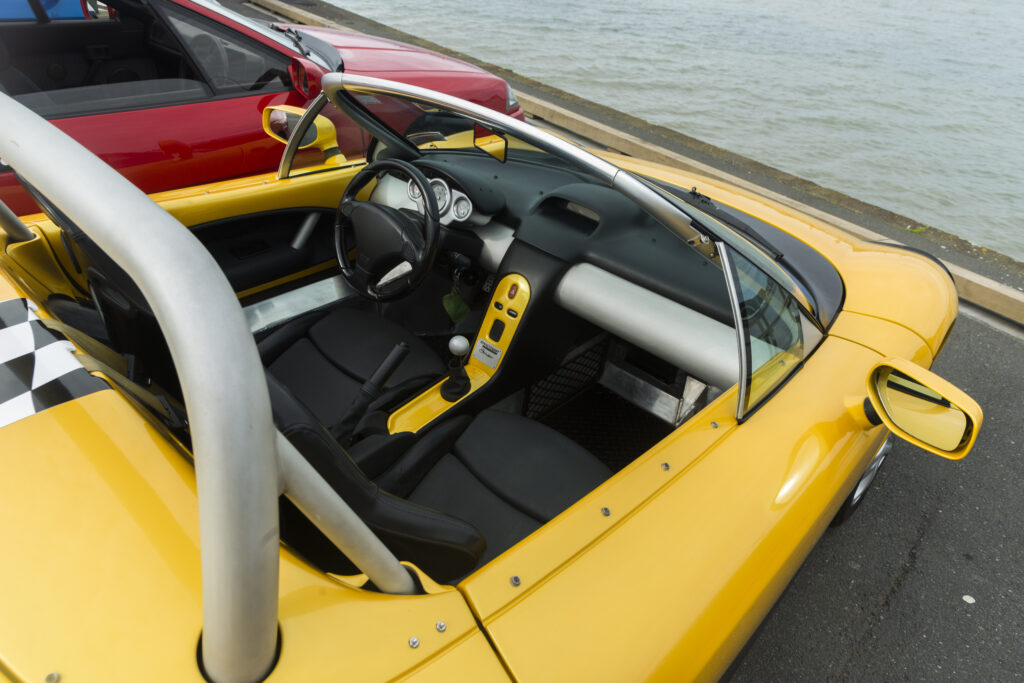Renault Alpine GTA, Clio V6 Phase 1 and Spider
While other makers rely on a consistent look and feel to create a brand identity these very different cars show that at Renault, creativity and flair is their core identity
By Ian Parkes
Photographs: Stephen Perry
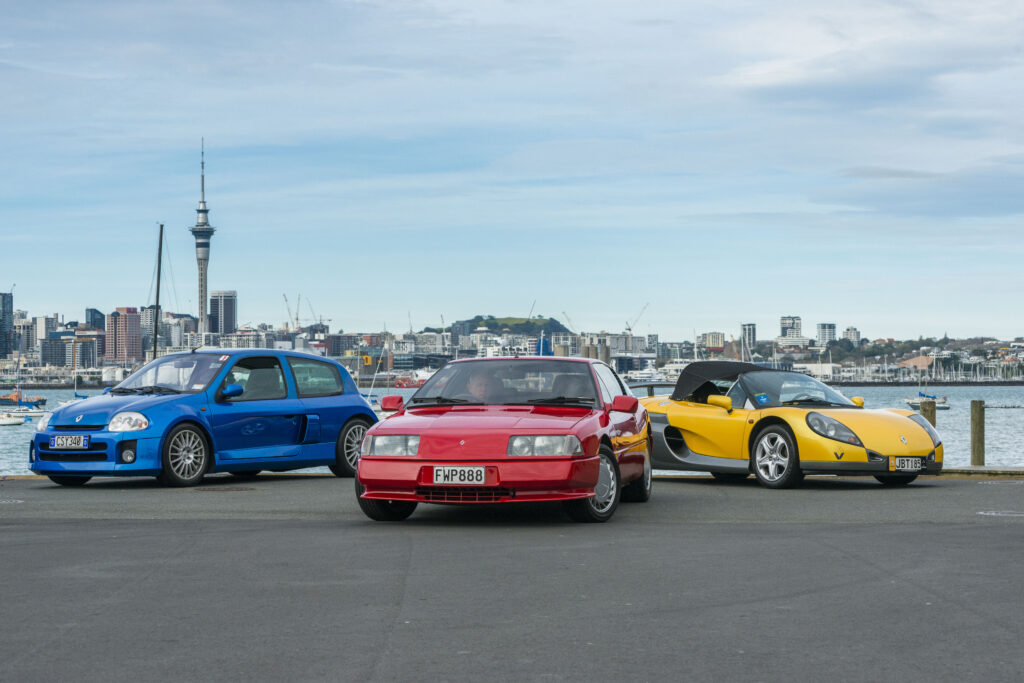
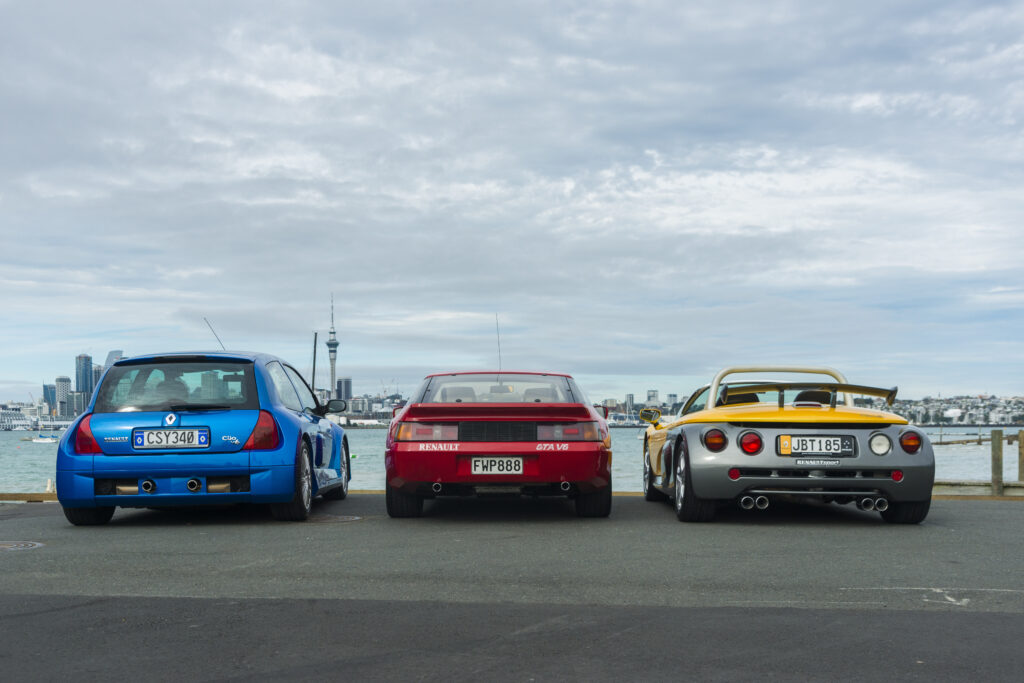
The Renault Alpine GTA is a car that seems to attract admiration without much enthusiasm. Its slightly hunched rear and slightly overlong and fairly bland nose don’t say sports car like the pouty Porsche 911s of the same vintage do, nor do they say grand tourer like Bentleys do. Of course, they cost much less but even so their appeal is a lot more subtle. The previous model, the A310, was criticised for being underwhelming and this car was probably also unfairly weighted with low expectations. Perhaps the car’s biggest burden was the Renault name. As a maker of practical if quirky French saloons, Renault didn’t have the same éclat as Porsche, Lotus, and Jensen, let alone Ferrari or other exotica.
A previous Alpine, the A110, built by that specialist maker using Renault mechanicals, set the world alight by winning the Monte Carlo rally in 1971 and the inaugural World Rally Championship. It took the creation of the Lancia Stratos, the world’s first purpose-built rally car, to end the Alpine’s reign. Renault thought acquiring the little Alpine concern — or Alpeen, as they say — was its shortcut to a more lucrative market segment. However, instead of elevating the Renault name, it’s sadly more the case that the Alpine name was borne down to Renault’s level. Its problems were compounded in the sports car market next door in the UK, where the Alpine name belonged to Sunbeam, then Chrysler Talbot. That meant the French car had to be marketed in the UK as the Renault GTA, entirely missing out on Alpine’s reputation and engineering legacy.
A Renault GT? Whoop de do
In fact, Renault was so discouraged by the experience that it mothballed the Alpine brand until some of its irrepressible engineers brought it back in an award-winning tribute, also called the A110, in 2017. Once again the Alpine, featured in issue 351 of this magazine, took on and bettered the usual competition from Porsche. I’m personally pleased to report that, after experiencing the French car, at least one Kiwi owner gave up his Porsche Cayman to get one — not me, I hasten to add, in case anyone gets the wrong idea about journalism pay rates. Hopefully, the new Alpines are selling in satisfactory numbers overseas because, for boring money reasons, Renault New Zealand is not selling the new A110 here.
So, back to the GTA. These appear to have been seen as worthy and maybe even deserving of greater success but the reality of relatively slow sales means that those who could or would proselytize on the car’s virtues — those who had owned or even driven one — were few in number.
Kimball Gaitely is one such person. He bought this Renault GTA in 1992 and he loved it so much he bought a second one, which was actually the launch car and demonstrator model in New Zealand. Kimball tidied it up before conceding he really didn’t need two of them and sold it to the car magazine writer who road-tested it at launch.
For some, part of the pleasure in classic cars is seeing them appreciate in value. Kimball is content simply to have the GTA as a car that he appreciates. His taste in such matters stands up to scrutiny. He has a collection of cars that demonstrates his passion and a rather single-minded focus on brilliant sports cars. His garage includes a Lotus Esprit Turbo — the V8 model — a Porsche 911 turbo, a Lancia Delta Integrale Evo 1, an Alfa Romeo 4C, a Lamborghini Murcielago, and a nearly-mint, low-mileage 1990 Toyota Supra, which he decided to buy mostly to keep it out of fevered tuners’ hands.
Kimball had a long career in cabin crew for the national carrier. He turned stopovers in the UK into the occasional shopping trip among the treasure trove of vehicles on offer there.

Three Renaults to the fore
Kimball says he has owned around 200 cars, up to and including Ferraris and similar exotica, so we should take note that he has no fewer than four Renaults in his collection.
The three we lined up to feature in this issue show amazing breadth and flair, just in that vast conglomerate’s sports car output. Perhaps that in itself suggests a reason Kiwis have found it hard to get a handle on the brand’s identity, beyond its Frenchness.
While Renaults, among many other marques, have come and gone in Kimball’s collection, the GTA has been a fixture.
“It’s just such a clever design,” he says. Its polyester and fibreglass body makes it lighter at 1220kg than its Porsche 944 rival. While not notably wind-cheating in appearance — its square front looks bluffer in photos than it does in real life, it was also aerodynamic for its time, with a touted drag coefficient of 0.28. Its integrated bumpers helped. Its predecessor A310 had conventional bumpers, although Renault had pioneered the integrated concept in 1971 on its Renault 5.
Like both of its ancestors the car has a central backbone chassis but with outriggers for side impact protection. Instead of being a single-piece moulding like the A110 and the A310, the body is made up of smaller panels, which made it much faster to assemble, down from 130 hours to 77 — although it was still a hand-built process.
Its naturally aspirated 2849cc rear-mounted PRV V6 engine from the Renault 25 with five-speed gearbox from the Renault 30 is mounted on a separate subframe, which means it can be dropped out in less than two hours.
The engine is on display through the rear window of Kimball’s GTA. He prefers to leave off the moulded engine cover, which has channels built into its underside that feed air to the right places on the turbo models. Kimball’s 1987 GTA is one of just 212 right hand drive versions of the 1504 carburetted cars produced. Renault built 4664 GTA turbos. Interestingly, 19 of the GTAs sold new here, of which this one, were non-turbo cars and just three were the turbo model, which was introduced a year after the car’s launch in 1984 . The factory was set up to produce 10 cars a day but over its six-year production life averaged just three a day.
Kimball has replaced the unusual carburettor set-up, which featured two different sized carbs, with a twin-choke Weber to improve its bottom-end power. It also does without an air cleaner, but the engine’s satisfying roar is kept at civilized levels in the cabin, separated by an internal glass screen.
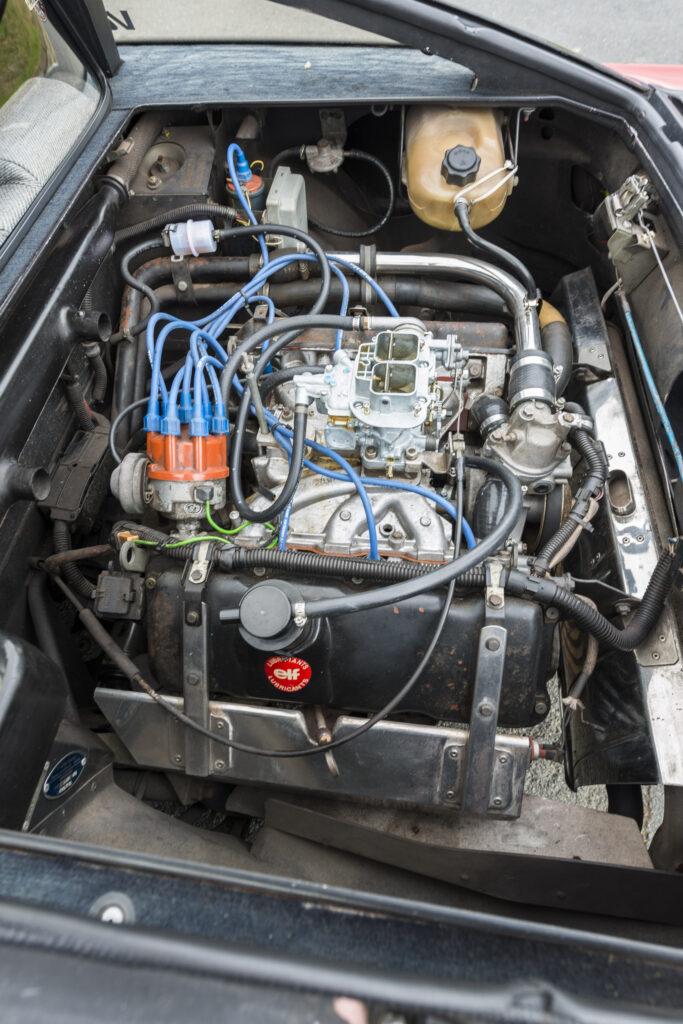
A certain je ne sais quoi
The interior of the car misses the opportunity to announce it is something special. The dashboard is square and unsporty and, as material science has come on massively over the decades, the interior looks too plasticky — although, to be fair, the plastics in Porsches of the era are hardly any better. The massive control console for the sound system, which incorporates a graphic equaliser, would have been very space age at the time. The whole thing looks as if it will warp in the heat although very little distortion has taken place. The squared-off door cards and trim, on the other hand, look modern and well designed. They make the swoops on almost all modern car door trims look samey.
As this car was marketed as a GT rather than a sports car, the front seats were plain and unsupportive. Kimball has replaced them with Recaro seats, but this isn’t obvious at first glance. They look the part until you notice the different fabric on the rear seats. He’s also added a sportier steering wheel, as the light steering can handle a narrower diameter wheel.
Kimball says the car is still a classy conveyance on longer trips. It’s the closest thing he owns to a normal car. Driving the car around the streets of Auckland doesn’t give it a chance to show off its best features, but as you’d expect in a French car the suspension is plush, which makes this fairly high performance car comfortable around town. A prod on the pedal provokes the right response, without the hesitation you might get from a turbo motor of this vintage. It’s a very torquey unit, especially with the Weber conversion. That came in very handy when a bit of the linkage fell off and Kimball couldn’t get out of fifth gear. Kimball said it was not an issue on the motorway but as he stopped on the motorway off-ramp, which actually goes uphill, he had it all to do. “It pulled away in fifth, no problem,” he says.

Virtues up front
Renault’s efforts to create a sophisticated GT are more evident in the way it drives than in any other sphere. It’s very easy for someone used to modern cars to step in and drive it. And the frankly bonkers dance the outward-facing windscreen wipers do is also sure to raise a laugh. Otherwise, the clutch is light and the engine responds smoothly to the accelerator. As the gearbox is attached to the forward end of the rear-mounted engine, the gear change, operated by short levers, doesn’t feel especially sporty but it works well enough, and it’s better than the one in Kimball’s Lotus Esprit, which has the gearbox at the back.
Around town then the car hides most of its virtues, except that a hint of its lightness and its rear engine does come through. As with Porsche’s 911, it makes a virtue of the rear-engine layout. The engine was moved a smidgen further forward than in the A310 to improve its overall balance but the front end is still very responsive, and very easily placed, which again makes it an easy drive.
Kimball bought this car when it came up for sale 28 years ago. His previous car was black but this one was red like 44 per cent of its brethren. A few years ago Andy Booth, the New Zealand V8 championship driver who has a New Zealand Grand Prix and the Denny Hulme Memorial Trophy to his credit, told Kimball it looked very like the car his parents had owned. When he checked the number plate, he realised it was the selfsame car in which his parents had taken him to school.
Sophisticated insanity
The Renault Clio featured here also has a V6 but this engine is the three-litre 24-valve unit from the Renault Laguna, uprated to 169kW (227bhp). When applied to a little hot hatch you’d have to think it turns this roller skate into a monster.
Kimball suggested I wind down the passenger’s window when driving it. The engine is quite loud when you are in the car, because it is in the cabin with you. As the not at all subtle air scoops on the side indicate, this is a mid-engine rear-wheel drive car. The engine is bolted in under a cover where the rear seat ought to be. But wind down the window and prod the accelerator and you get the full benefit of the induction roar and exhaust bass notes bouncing off the scenery. The engine is smooth but the uneven firing of the V6 adds enough syncopation to make it utterly stirring.
“The noise it makes alone is enough to make you buy the car,” says Kimball.
This car shows the wild enthusiasm of French carmakers in a different way to the other two cars featured here. Take a basic, effective shopping hatch, throw away most of the things that make it practical, and stuff it full of power and go faster bits. Add a massive body kit. No, forget that. Reshape all the wings to cover those fat tyres. It’s boy racer stuff approved at board level. It is based on the Mark 2 version of the Clio but after its transformation it shares very few parts with that car.
There’s just one thing that makes this seem logical. Renault did something very similar to create the Renault 5 Group B rally car. However, there is a big difference between this car and a boy racer special. It is massively sophisticated. While the body bulges change the proportions and stance of the car dramatically, announcing its power, it is, in its way, subtle and complete. The front wing is sharply raked back into the standard doors and the rear wings, incorporating the scoops, are a masterpiece of curves and creases. Rather than just having added bulges, the car has gorgeous new rear wings with a bold curve following the wheel down to the sill.
Kimball prefers the Phase 1 to its successor, the Phase 2. That this car was produced by Tom Walkinshaw Racing rather than in-house like the Phase 2 is one reason, but also it still has the rounder, more distinctive, and innocent-looking headlights.
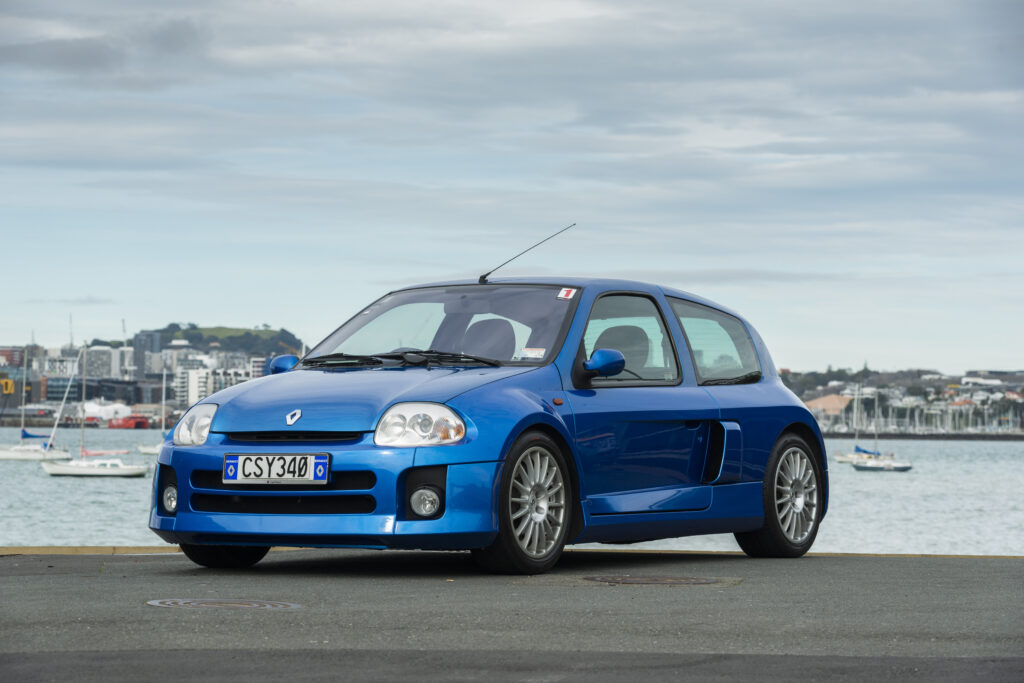
Delight delayed
Kimball fell in love with the car when it was launched and enquired about it immediately but at $100,000 it was much more expensive here, over the base car’s price, than in the UK so he held off. However, the owner of a specialist Renault garage offered him this one a few years ago. It was sold new in Singapore but came here after only about a year. Kimball leapt at the chance.
“Every time he sees it, he says he shouldn’t have sold me that car,” Kimball tells us.
TWR had to substantially re-engineer the car to swap the engine location and get it to handle the power, so it weighs quite a bit more than the standard car. At 1355kg, a third heavier than the one-tonne standard car, it is no longer a light little shopping basket. But it works.
The weight means it is not likely to throw you off the road when you give an incautious dab to the throttle. In fact, it is not much faster than the sportiest front-wheel drive Clio, ticking off 0–100kph in around 6.3 seconds compared with 6.8 for the Clio Cup, but its top speed is substantially faster at 235kph. This engine also delivers its power at the top end of the rev range. When you want to get serious, it does too.
Walkinshaw also sorted the suspension, of course, and added bigger wheels and brakes. While the ride is firmish, holding promise, the car is still French so still very comfortable around town. Despite the apparent madness the car is actually very civilised to drive. That’s French sophistication for you. The gearbox also, in typical French fashion, is not especially sweet. It’s a bit clicky, but it works better and unobtrusively when warm, and the clutch is probably as light as that of the standard car.
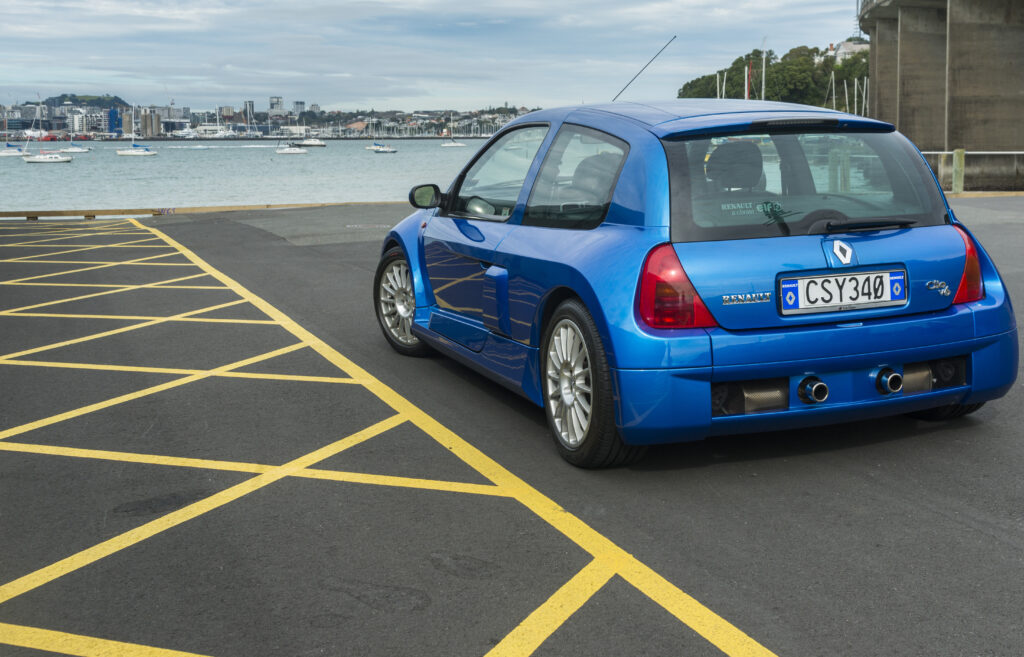
Great sensations
The steering is also light, because there’s virtually nothing in front of you apart from the battery and servicing points for water and oils below a plastic liner under the bonnet. As with the Alpine, the mid-engine layout allows you to place the front of the car swiftly and accurately, making it very easy to drive. Kimball says a bit of understeer was built in, perhaps as a warning as on the limit it flicks quickly into oversteer.
“At that point it’s a tricky car to handle,” he explains.
There is nothing to distract from the enjoyment of pressing the loud pedal at every opportunity, and at higher speeds the poise — and the presence — of the mid-engine layout makes this car feel very special indeed.
The interior is frankly disappointing — apart from just a couple of welcome features. The Recaro seats look the business but the dashboard is basic ’90s economy car in uninspiring shades of grey. I’m rarely in favour of aftermarket steering wheels — so ’70s — but this car deserves something to make it look from the driver’s seat as special as it feels. It does have a very nice little plaque from TWR between the seats indicating its limited numbers provenance but that’s out of view. So, once again, while others looking at the car from outside see something special, for the driver it is the sensations the car delivers that convey its rare appeal — and it’s churlish to argue with that.
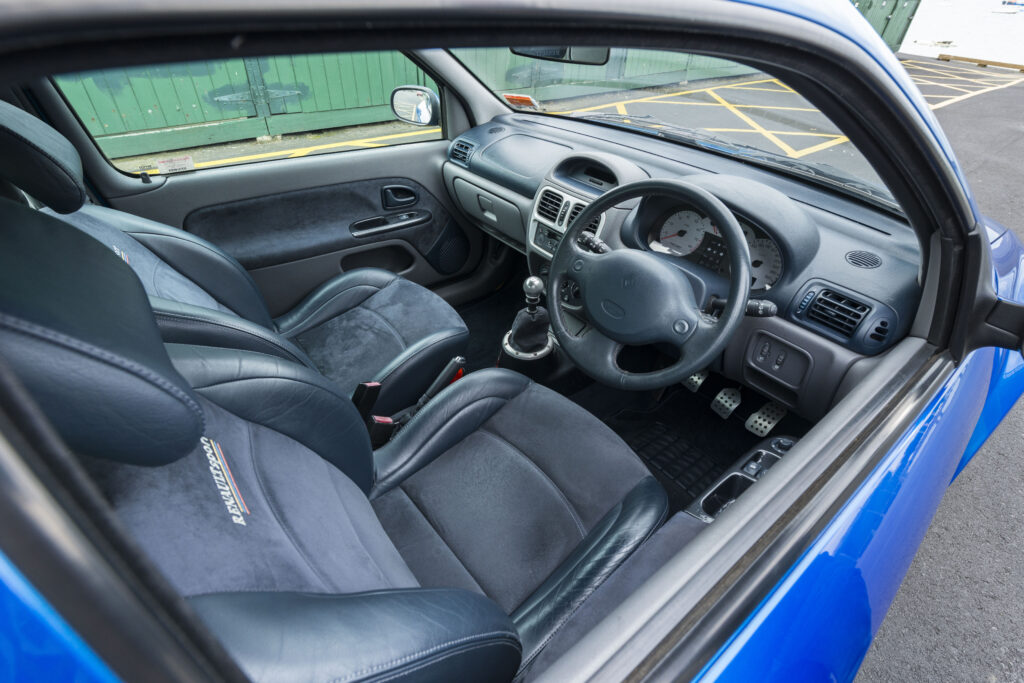
A rare treat
Rare this car certainly is: just 1513 Phase 1s were built by TWR in Uddevalla, Sweden. The 1309 Phase 2s, although developed by TWR, were built by Renault in Dieppe, as were the other two cars here. At its launch the Phase 2 was the most powerful production hot hatch in the world, with 188kW (252bhp), outranking even the ferocious Alfa Romeo 147 GTA (184kW, 247bhp). Claiming those bragging rights is something Renault works at quite assiduously to this day. There was also a Trophy version of the Clio V6, built for racing, complete with a sequential gearbox and a roll cage. That car, designed to promote the Clio range in a one-model race series, replaced the Renaultsport Spider Trophy, another one-model race series designed to wave the flag for Renault.
That brings us neatly to the third car in our line-up. If the other two cars are conventional in some respects, the Renault Spider shows Renault’s creative flair in full flight. It possibly aimed to bridge the gap between Renault’s road-going cars and its Formula 1 bleeding-edge expertise. It says so much about this car — from a mainstream manufacturer — that the first models were designed and sold without a windscreen, although they had a funky-looking aerofoil deflector.
I remember, when this car was launched in 1995, applauding the simplicity and purity of its lines and its uncompromising appeal to enthusiasts. The lines are still strong and if they have aged — a bit, I guess — their simplicity, purity, and promise are still fully intact. There is no doubt Kimball is an enthusiast so it is no surprise that he took the chance to acquire it. It was offered to him by the same specialist who sold him the Clio at an attractive price, because he knew it was going to the right person. This 1997 Spider came to New Zealand from Germany.i
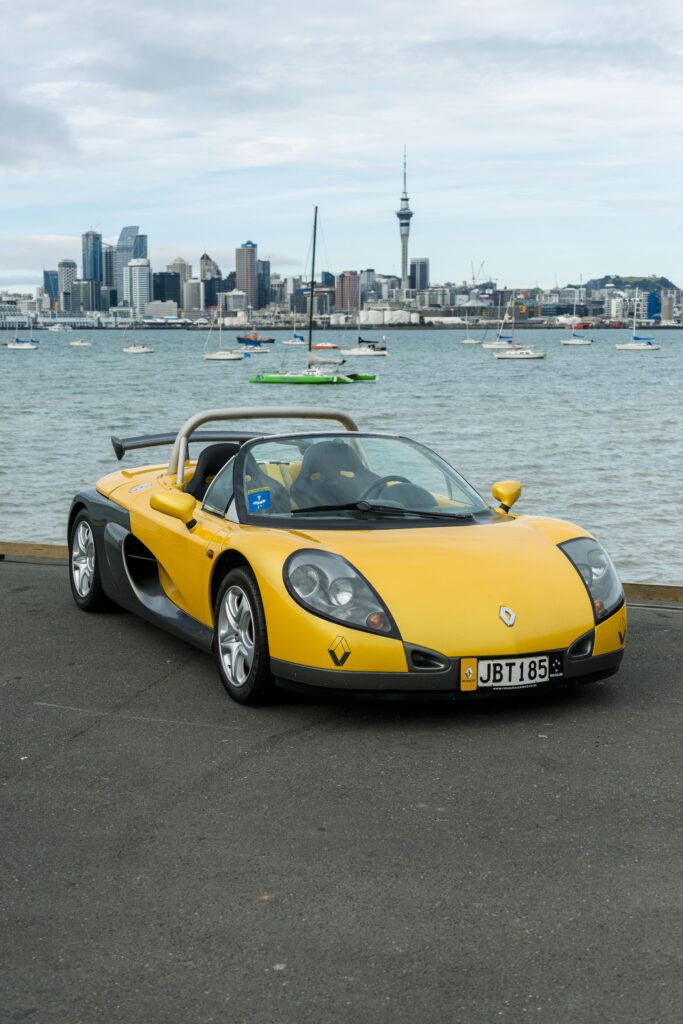

Foam sandwich
What is more notable about the car today is its innovative construction. Its chassis is made up of flat carbon honeycomb composite panels glued to an aluminium space frame, territory shared only with Lotus. It was probably the arrival of the Elise, lighter, quicker, and cheaper, that spoiled the Renault party, and contributed to its rarity today. Just 1700 were built in total and officially fewer than 100 were made in right-hand drive form for the Elise’s home market.
The performance from its 150bhp 2-litre 16-valve four cylinder engine from the Clio Williams is unremarkable today, giving a 0–100kph time of around 6.5 seconds but this 930kg car is all about handling. Kimball has taken it to track days and says, while he can’t live with the likes of (much newer) Lotus Exiges, it goes round the corners as fast as anything on the track.
If you are not going to have a windscreen forget about power steering or assisted brakes but in line with its race car intent the pedals are adjustable. The seat doesn’t recline or move back but the seat squab can be raised or lowered. There’s no heater, and air conditioning is of the original kind only. The car doesn’t even have exterior door handles, so if you are not going to scramble over the side — say you want to open the upwards-hinging doors for dramatic effect — you have to reach inside for the internal handle. A radio was an optional extra, and there are no airbags. You get an instrument binnacle with the analogue rev counter front and centre. The digital speedo, fuel gauge, and clock display are mounted in the centre of the dash, meaning the passenger can keep an eye on them. There’s a centre console covering a structural beam but elsewhere, in the footwell and the sills, the bare aluminium is on display. The Recaro seats are covered in a waterproof fabric, as most cars were shipped with nothing more than a tonneau cover.
Kimball’s car is rare indeed in that not only does it have a windscreen — Renault conceded on that point, making it an option after the first year — but it also has a rather nifty hood. He hasn’t seen another car with one. It’s not pretty but it is pretty functional and it suits this military-spec car.
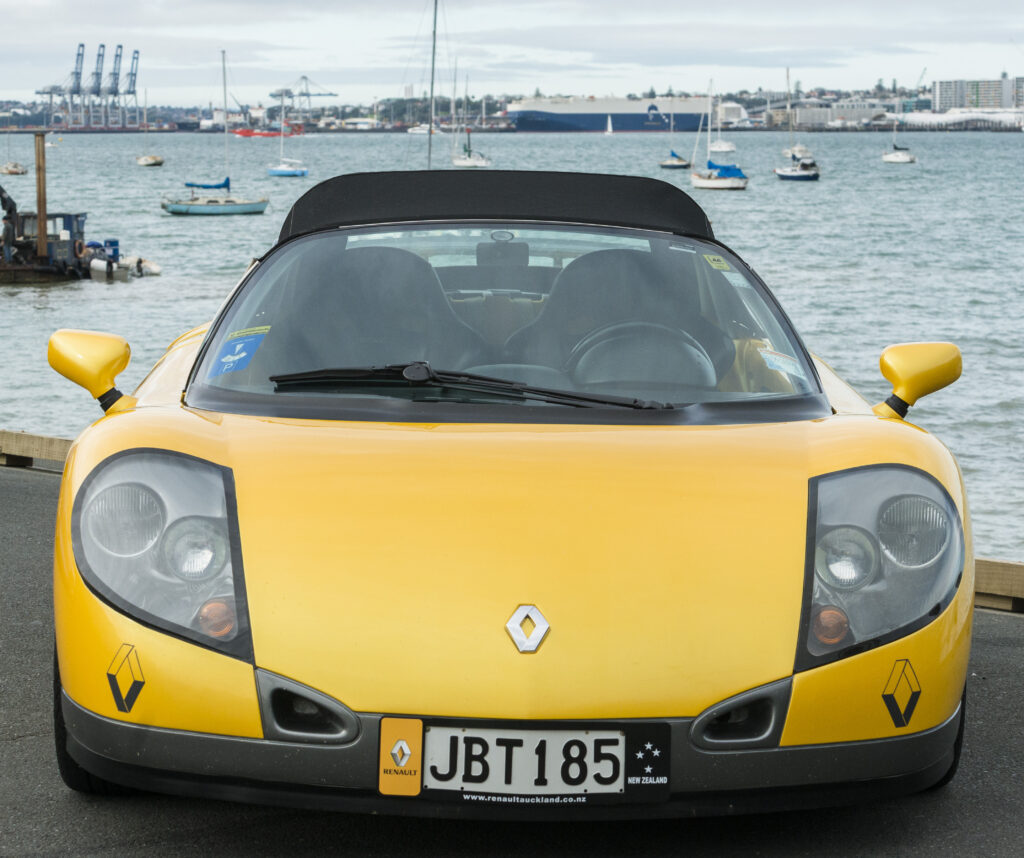
Dedicated to drivers
The Trophy spec race cars got a more powerful engine (210bhp), a six-speed gearbox, and a full roll cage. The mid-mounted engine is tucked in tight behind the cockpit. Flipping the clamshell front bonnet reveals a small storage bin, washer bottle, tool kits, and nothing much else, although it does give you a view of the raw edge of the carbon. Both front and rear adjustable shock absorber units are mounted inboard, again to improve handling.
The car, like the others, is also very responsive, especially in the steering but, as you’d expect, the feeling is even more naked and real in this car. You have to twist the gear knob to engage reverse but everything else, even the gearbox and cable-operated clutch, feels very direct. The sensations of driving in this car are heightened, like few other cars. It’s probably the closest thing to a go-kart you can get for the road. We didn’t get the chance to try it, but if you are not on a racetrack, a tight mountain road must be enormous fun in this car.
So, Kimball, what is it about Renaults? Many years ago Kimball had a Porsche 911E and he had just acquired his third speeding ticket on the roads around Lake Benmore. He realised if he carried on in that vein he would lose his licence, so he sold the car, virtually on the spot, to a friend who still owns it today. Then he bought a Renault 12TL — just about the unsportiest car you can imagine at the time. After that came two Renault 18 Turbos, a Fuego, an 11 Turbo, a 5 Turbo, and a 5 GTX.
“Then I bought the Alpine GTA and that was it. I’ve never had a problem with the engines in any of my Renaults. They were always reliable. You know if you have problems with a car you can go off them very quickly.”
One of Kimball’s early cars was a three-litre CSA BMW. He also had a 3.0 CSi manual. They are worth moonbeams now, but he had problems with both of them.
There was a trick you could do with the Renault 11 Turbo to increase the boost. He did that but the car is still going strong. Kimball has checked up on all of his previous Renaults and they are all still registered or on hold.
“They were also always very comfortable,”he says.
The Renault 11 didn’t have a reclining backrest but the whole seat was mounted on cived rails so you could roll it back like a rocking chair — simple, effective, and comfortable.
All of Kimball’s cars, even his daily driver — see page 104 — are serious sports cars, but if several of them are Renaults, well, for most of them at least, comfort comes along with the ride.
